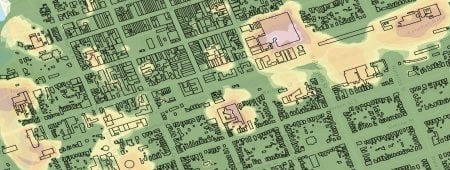Migration Patterns Reveal Much about US Population, Research Finds

The drop of Detroit’s population is well documented, but a Michigan Technological University researcher says there is a surprising kernel of information in the decline.
Richelle Winkler, assistant professor of social sciences, says Detroit attracted fewer young adults in the 1980s and 1990s than did revitalizing cities like Chicago. Then, with the economic recession between 2000 and 2010, more young people actually left Detroit than people of other ages.
“In this extreme situation, the young were more likely to move out,” she says, “because they are more mobile and not as tied to families and mortgages. This kind of shift in the signature [age-based pattern] is rare and indicative of real and profound socio-economic change.”
Winkler’s work is part of a new population-map website, Net Migration Patterns for US Counties housed at the Applied Population Laboratory at the University of Wisconsin–Madison.
According to the site, every year about 10 million Americans move from one county to another, and these migration rates vary by age, race, ethnicity and economic conditions over time.
Winkler has been tracking these patterns of people moving around the US, from the 1950s through the 2000s, and she’s uncovered some important trends, things you might expect--or not.
“We can trace the movements of blacks from the South, for example, when they moved into the North and Midwest in the 1950s as they migrated to get jobs,” she says. “But by the 2000s, blacks were no longer leaving the south, just moving from rural areas toward southern cities, just as southern whites do.”
Since the data is broken down by age, Winkler and her fellow researchers from New Hampshire, Princeton, Wisconsin-Madison and North Carolina also traced people in their twenties, for example, as they moved into cities and college towns over the years.
“Individual counties’ age-specific migrations do tend to be consistent over time,” she says, “telling demographic stories about local places.”
Researchers were also able to identify the “rural rebound,” of the 1970s, when a lot of folks moved back to the country. This return-to-nature movement also occurred as manufacturers moved out of cities, and it has included retirees over the years.
“Rents were lower, there was a back-to-the-land movement, people started raising their own food,” Winkler says. “Then, in the 1980s, it flipped again. Rural America faced the farm crisis, and migration patterns shifted back toward metropolitan areas.”
By the 1990s and 2000s, she says, overall movement became balanced between city and country, with young adults moving toward cities and retirees moving toward more rural areas.
“Work has a lot to do with it,” she says, “but there are other amenities like nature. The role of the environment shifts over time. People moved out of the Northeast and Midwest going to the South and West.”
She uses Chicago as a classic example of a city in the Rust Belt with a central-city “migration signature.” Young adults move into the city, while families with children and those at retirement age move out. Most central cities display this kind of age-based migration pattern.
The researchers have identified some overall findings. In addition to young adults (25 to 29) migrating to cities away from rural areas, family-age migrants (children age 5 to 14 and adults age 30 to 49) are continuing to leave large urban cores for the suburbs, and major metro areas in the Northeast and Midwest are losing older migrants (age 50 to 74).
From 1990 to 2010, those older adults showed strong tendencies to move toward locations with natural amenities, like lakes, mountains and coasts, and to places with mild climates. Locations favored include the Ozarks, North Carolina, South Carolina, Texas, North Woods lakes destinations like northern Wisconsin, Minnesota, and Michigan (including the UP), Arizona and Florida. Retirees moving to an area spike the need for more services, from health care and restaurants to theaters and service stations.
Also of note:
• Young Hispanics and non-Hispanic whites move to cities at the heart of metro areas at the highest rate.
• Blacks of every age are leaving large urban centers. At the same time, blacks of every age are moving into suburban counties.
• Some oil-rich North Dakota counties such as McKenzie are experiencing an influx of young adults and families after decades of seeing them leave.
All this data came from working with the US Census and with the National Center for Health Statistics.
It’s a lot of data on a very extensive website, but it’s fun and easy to use.
“We want the site to be accessible and intuitive,” Winkler says.
For the future, she’d like to do more in-depth analysis of the data, including using it to answer questions about how environmental, economic and social characteristics of places explain migration patterns among different age groups and how this is changing over time.
Michigan Technological University is an R1 public research university founded in 1885 in Houghton, and is home to nearly 7,500 students from more than 60 countries around the world. Consistently ranked among the best universities in the country for return on investment, Michigan's flagship technological university offers more than 185 undergraduate and graduate degree programs in science and technology, engineering, computing, forestry, business, health professions, humanities, mathematics, social sciences, and the arts. The rural campus is situated just miles from Lake Superior in Michigan's Upper Peninsula, offering year-round opportunities for outdoor adventure.




Comments